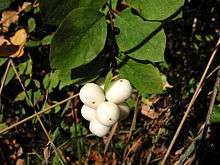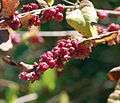Symphoricarpos
| Symphoricarpos | |
|---|---|
 | |
| Common Snowberry (S. albus) | |
| Scientific classification | |
| Kingdom: | Plantae |
| (unranked): | Angiosperms |
| (unranked): | Eudicots |
| (unranked): | Asterids |
| Order: | Dipsacales |
| Family: | Caprifoliaceae |
| Genus: | Symphoricarpos Duhamel 1755[1][2] |
| Synonyms[3] | |
| |
Symphoricarpos, commonly known as the snowberry, waxberry, or ghostberry, is a small genus of about 15 species of deciduous shrubs in the honeysuckle family, Caprifoliaceae. With the exception of the Chinese coralberry, S. sinensis, which is indigenous to western China, all species are native to North and Central America. The name of the genus is derived from the Greek words συμφορειν (symphorein), meaning "to bear together", and καρπος (karpos), meaning "fruit". It refers to the closely packed berries the species produce.[4]
Description
Symphoricarpos leaves are 1.5–5 cm (0.59–1.97 in) long, rounded, entire or with one or two lobes at the base. The flowers are small, greenish-white to pink, in small clusters of 5–15 together in most species, solitary or in pairs in some (e.g. S. microphyllus). The fruit is conspicuous, 1–2 cm (0.5–1 in) in diameter, soft, varying from white (e.g. S. albus) to pink (S. microphyllus) to red (S. orbiculatus) and in one species (S. sinensis), blackish purple. When the white berries are broken open, the fruit inside looks like fine, sparkling granular snow. The flesh is spongy and contains two 2–5 mm long, whitish stone seeds. The seeds are egg-shaped and more or less flattened which contain endosperm and a small embryo. They have a very tough, hard, and impermeable covering so the seeds are very hard to germinate and may be dormant for up to 10 years.
The white berries create a cracking sound when they are stepped into firm ground.
- Species
Species accepted as of August 2015[5]
- Symphoricarpos acutus (A.Gray) Dieck – Sharpleaf snowberry: California, Nevada, Oregon
- Symphoricarpos albus (L.) S.F.Blake – Common snowberry: Canada + USA
- Symphoricarpos ×chenaultii Rehder – Chenault coralberry
- Symphoricarpos ×doorenbosii Krüssm.
- Symphoricarpos guadalupensis Correll – McKittrick's snowberry: western Texas
- Symphoricarpos guatemalensis J.K. Williams: Guatemala
- Symphoricarpos hesperius G.N.Jones – Trailing snowberry: California, Baja California, Oregon, Washington, British Columbia
- Symphoricarpos longiflorus A.Gray – Desert snowberry: southwestern USA, northwestern Mexico
- Symphoricarpos microphyllus Kunth – Littleleaf snowberry: Mexico, Guatemala, New Mexico
- Symphoricarpos mollis Nutt. – Creeping snowberry: California
- Symphoricarpos occidentalis Hook. – Western snowberry, Wolfberry: USA + Canada
- Symphoricarpos orbiculatus Moench – Coralberry: northeastern Mexico, eastern + central USA
- Symphoricarpos oreophilus A.Gray – Mountain snowberry: northern Mexico, western USA, western Canada
- Symphoricarpos palmeri G.N.Jones – Palmer's snowberry: Mexico, southwestern USA
- Symphoricarpos parishii Rydb.: California, Nevada, Baja California
- Symphoricarpos rotundifolius A.Gray – Roundleaf snowberry: Mexico, southwestern USA
- Symphoricarpos sinensis : China
- Symphoricarpos vaccinioides Rydb.: California
Ecology
Common snowberry (S. albus) is an important winter food source for quail, pheasant, and grouse, but is considered poisonous to humans. The berries contain the isoquinoline alkaloid chelidonine, as well as other alkaloids. Ingesting the berries causes mild symptoms of vomiting, dizziness, and slight sedation in children.
Cultivation and uses
Common snowberry is a popular ornamental shrub in gardens, grown for its decorative white fruit and wildlife gardening.
- Symphoricarpos albus flowers
 Symphoricarpos orbiculatus fruits, mid-October
Symphoricarpos orbiculatus fruits, mid-October Symphoricarpos vulgaris . Drawn by Eersde Deel, 1813.
Symphoricarpos vulgaris . Drawn by Eersde Deel, 1813.- Symphoricarpos orbiculatus fruits in winter
- Symphoricarpos orbiculatus fruits in autumn
References
- ↑ "Genus: Symphoricarpos Duhamel". Germplasm Resources Information Network. United States Department of Agriculture. 1998-09-18. Retrieved 2011-09-13.
- ↑ "Symphoricarpos". Integrated Taxonomic Information System. Retrieved 2011-09-13.
- ↑ Jones, George Neville 1940. A monograph of the genus Symphoricarpos. Journal of the Arnold Arboretum 21(2): 201-252
- ↑ Everett, Thomas H. (1982). The New York Botanical Garden Illustrated Encyclopedia of Horticulture. Taylor & Francis. p. 3271. ISBN 978-0-8240-7240-7.
- ↑ The Plant List, search for Symphoricarpos
External links
| Wikimedia Commons has media related to Symphoricarpos. |
| Wikispecies has information related to: Symphoricarpos |
- USDA PLANTS Profile
- Winter ID pictures
- Canadian Poisonous Plants Information System Notes on poisoning: thin-leaved snowberry
- Symphoricarpos orbiculatus images at bioimages.vanderbilt.edu